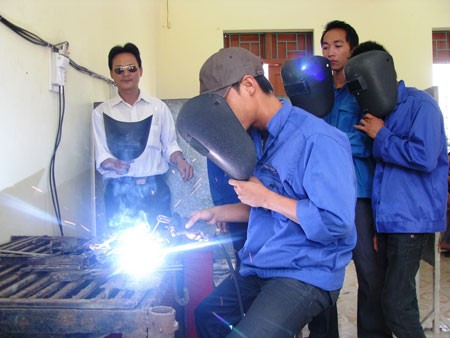(VOVworld) – The ASEAN Economic Community will be officially established at the end of this month. Pursuant to signed agreements, ASEAN member countries will accept each other’s qualifications. In other words, workers qualified in one country are permitted to work freely in other ASEAN countries. This will benefit Vietnamese laborers and students but also pressure Vietnamese education to reform and improve its training and personnel.
 |
| Students at a vocational school. |
The ASEAN Economic Community will not only boost the free flow of goods, services, and investment, but also allow skilled workers to move freely in the ASEAN market, home to 300 million people of working age.
In the short term, accountants, architects, dentists, doctors, engineers, nurses, porters, and tour guides will be the biggest beneficiaries of the ASEAN mutual recognition agreements.
To maximize this opportunity, Vietnamese workers should be trained in a profession and excel in a foreign language, ideally English.
Nguyen Dang Minh of National University Hanoi, said this is the weak spot of Vietnamese human resources, adding “our young workers have several limitations. One of them is their lack of confidence in fundamental skills like communications and foreign languages.”
Linh Chi, a student at National Economics University Hanoi, shared her practical experience when she participated in international volunteer activities as a team leader.
She said: “when young Vietnamese people work in a team of their peers from different countries, they likely have good professional knowledge but find it hard to express or present it due to language barriers. This makes Vietnamese youths less confident.”
A recent World Bank survey of workers in seven ASEAN countries showed Vietnamese workers near the top of the list in professional skills and work attitude. But Vietnamese workers need better communication skills, English skills, and skill in handling unexpected problems.
Doctor Le Dong Phuong with the Vietnam Institute of Educational Sciences said: “generally, Vietnam’s higher education system is in no way inferior to that of other regional countries. A number of Vietnamese education departments have been internationally recognized – in medicine and agriculture for example. But our higher education model is still focused on theory and lacks hands-on practice.”
To meet the challenge of an open labor market, the Vietnamese education sector is stepping up reforms, labor market management, and increasing the percentage of skilled workers.
Doctor Phuong noted: “the Ministry of Education and Training has proposed that the government issue a master-plan on personnel development until 2020 towards an education and training system compatible with the needs of the new period. The National Assembly has promulgated a Law on Higher Education. Over the past 20 years, the government has invested more in improving the quality of university lecturers - by sending them abroad to study, for an example.”